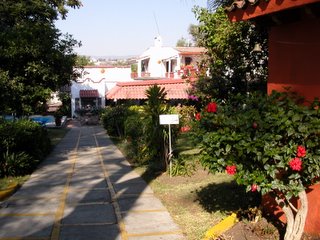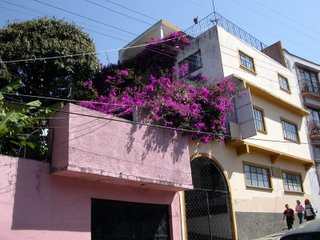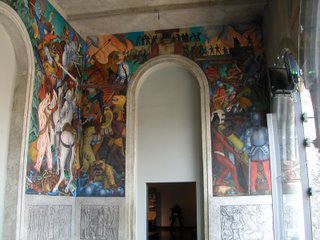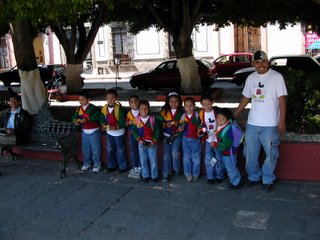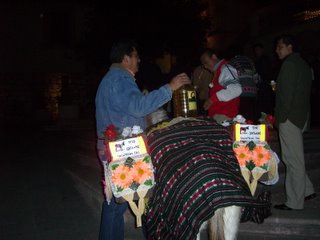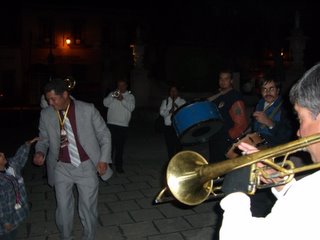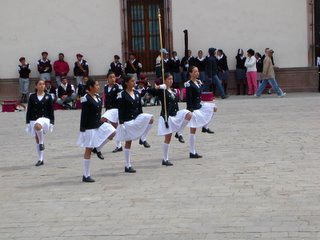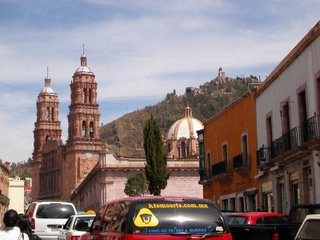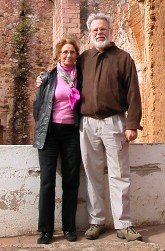
The main square in Tequisquiapan
So this time we figured we would miss all the traffic in the DF by going through on a Sunday morning. Unfortunately, we somehow ended up on the wrong side of the perimeter highway and were forced to go through the middle of the city, past the cathedral, past the Zocalo, past the Presidential office and past what we thought were the beginnings of a big political or labor demonstration on the Zocalo, but which turned out to be a national Boy Scout jamboree.
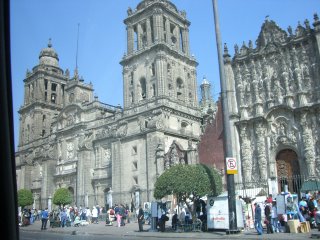 The Zocalo in Mexico City with the cathedral which is located over the site of the main temples of Tenochtitlan
The Zocalo in Mexico City with the cathedral which is located over the site of the main temples of TenochtitlanOur map was useless, and it was only my memories of the Conquista that got us back to the right side of town and on the highway to Querétaro. I recognized the name Tacuba (one of the cities on the old Lake Texcoco shore where Cortes headed on the night he tried to sneak out of Mexico City, la noche triste, but got caught on the causeway.) We just followed the signs from the Zocalo, which had been the center of the city of Tenochtitlan, to Tacuba. Sometimes knowing a little history pays off, not often, but sometimes.
Since our hotel reservations in Querétaro did not start until Monday, we decided to stay a night in Tequisquiapan, about an hour and a half north of the DF and half an hour from Querétaro, which had come highly recommended by Mexican friends in Atlanta and by people in Mexico. It is not in the guidebooks.
After a cobbled-stoned detour from hell, we finally arrived. By then I was prepared to hate the place, but how can you resist a beautiful, totally updated, and well-maintained and charming village that is doing everything possible to make visitors welcome.
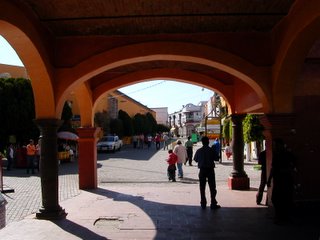 Tequisquiapan typical street scene
Tequisquiapan typical street sceneIt was originally built around thermal springs, but most of those are no longer in evidence, even though the hotels still call themselves spas. Everything is in easy walking distance, most of the center is blocked to traffic (of which there is very little anyway), the square is surrounded by restaurants and cafes, and there are at least two very nice handicraft markets with plenty of opportunities to buy the local basketry. Tequisquiapan is also a wine capital, mostly for export, and cheese. The idea being to buy your local wine and cheese and carry it home in a local basket. (No, we did not drink or eat any, nor buy a basket which are much more reasonable than Gulla or Cherokee baskets, next time.)

Outdoor crafts market

Tequisquiapan baskets
Monday morning we had breakfast on the square, a five minute walk from our hotel, and met Juan, our waiter. He knew a little English, but mostly we spoke Spanish, fractured though it may be. I have found that together, Christiane and I make up one adequate Spanish speaker.

Breakfast on the plaza
We talked about the town, the church, fiestas, etc., and during the conversation he said one very interesting thing. We were talking about how clean and well-maintained Tequisquiapan was compared to other places we had been, and wondered if it was because of good municipal government. That had never entered his mind apparently. He reckoned that it was because it only had Mexican tourists, mostly from the DF. He pointed out that San Miguel de Allende (the heartland for American expats about which many books have been written and about which the expats are very proud of the economic benefits they have brought to the locals) used to be nice too, but it has become dirty and run down because too many people who did not have a stake or attachment to it had moved in and were not taking care of it. Presumably the same could be said for Cuernavaca, Lake Chapala, Acapulco and Mazatlan, etc. You don’t learn stuff like that from speaking to tour guides in English. Learning a little of the local language not only makes life easier, but you sometimes get these little nuggets. We will be revisiting Juan and Tequisquiapan again as it is only a ½ hour from Querétaro and is very relaxing, plus we gotta check out the wine and cheese and maybe buy a basket.
On the way out of town we took the back way to Querétaro, and passed through some interesting towns and villages and got a good look at El Bernal, which looks like the mountain in Encounters of the Third Kind.

El Bernal
After we arrived, we started calling agents to visit houses, and thus met Jaime. He took us to a couple of places on Monday, and then on Tuesday, took us to two more. Most were not exactly what we were looking for, but he had a good handle on our price range, less than $6,000 Mex a month in the historic district. At the second house Tuesday, we noticed a vacant house nearby and asked the nextdoor neighbor what the story was. Norma and Christiane and Norma’s little grandson hit it off, and soon French music was playing and they were dancing.
I stayed with Jaime and Norma’s son and talked real estate, manly stuff. After much searching and visiting other neighbors we obtained the owner’s phone number and are meeting at the house this evening. Rent is within our range, and the place has been vacant for 8 months, and it has a papaya tree in the patio, a real live papaya tree, three bedrooms, two baths, lots of light and off street parking within a block of a market, and just downhill from the Templo de la Cruz where the Franciscans organized and outfitted missions to Arizona and New Mexico, and where one of the main national fiestas with Indian groups from all over the republic dancing, etc. for a week at Easter and Holy Cross day in September. If it looks as good as we think, it will be just right for us, and we will have good neighbors to watch out for us. But we don’t want to get our hopes up too much, because the owner is “muy dificil” according to Jaime. We will need to talk around the issue and get to know each other before ever mentioning any business, and hopefully Norma will put in a good word. Vamos a ver. (Should I italicize Spanish words?)
------------------
The owner was indeed "muy dificil". She wanted a six month deposit in lieu of a Mexican co-signer, and the house showed that it had been unoccupied for a year. Nevertheless, we are trying to work something out. If we cannot come to agreement by noon tomorrow, I have told Jaime to set up an appointment to sign a contract with another apartment we saw after meeting La Dueña. It is nearly new, well laid-out, closer to the center; but it is not as sunny, has no Papaya tree or garden, and parking is around the corner. However, it is in a better neighborhood, has two bedrooms, two full baths, a "cocina integral", whatever that is, and a study.
This morning, Wed., we spent three hours at the Express Cafe near the hotel talking with Maria and Bob and their Canadian friend Carl about everything from insurance to furnishings to health care to . . . Our Dutch friends from the other night who were supposed to have left Querétaro yesterday, decided to stay an extra day, and they dropped by to fill us in on what they had found out about the city, including where the nearest Carrefour (French super-duper market) is and how great the saucisson is there. They are very impressed with the city and think it will only get better. This is based on extensive world travel (they travel 2 months a year). The European system does have its advantages.
